This article was medically reviewed by Luba Lee, FNP-BC, MS. Luba Lee, FNP-BC is a Board-Certified Family Nurse Practitioner (FNP) and educator in Tennessee with over a decade of clinical experience. Luba has certifications in Pediatric Advanced Life Support (PALS), Emergency Medicine, Advanced Cardiac Life Support (ACLS), Team Building, and Critical Care Nursing. She received her Master of Science in Nursing (MSN) from the University of Tennessee in 2006.
There are 12 references cited in this article, which can be found at the bottom of the page.
This article has been viewed 50,381 times.
Because you are most fertile during ovulation, knowing when ovulation occurs is important if you are trying to get pregnant, or if you want to avoid getting pregnant. You can use your menstrual cycle to track your ovulation. However, if your periods are irregular, then you may want to use your basal body temperature (BBT) to determine ovulation. By examining your cervical mucus, you can also track your ovulation.[1]
Steps
Calculating from Your Menstrual Cycle
-
1Calculate how many days your menstrual cycle is. Your menstrual cycle starts on the first day of your period and ends on the first day of your next period. On a calendar, mark the first day of your period. Then mark the first day of your next period. Count how many days there are from your last period to your current one. This is how long your menstrual cycle is.[2]
- For example, if your period starts on June 11th and your next period starts on June 7th, then your menstrual cycle is 27 days.
-
2Track your menstrual cycle for 3 to 4 months. This way, you can get an accurate measure of your cycle’s length. If your cycle is 27 days during one tracking period, but 28 days during the second or third tracking period, then it is safe to assume that your cycle is 28 days.[3]
- If the length of your cycle is different each time, try tracking your basal body temperature (BBT) to determine your ovulation.
Advertisement -
3Subtract 14 from the length of your menstrual cycle. Ovulation typically occurs 14 days (2 weeks) before your next period. By subtracting 14 from the length of your menstrual cycle, you can determine your day of ovulation.[4]
- For example, if your menstrual cycle is 32 days, then ovulation should occur on day 18.
- You are most fertile during ovulation, as well as the 3 days leading up to ovulation. If your menstrual cycle is 32 days, then your most fertile days are day 15, 16, 17, and 18.[5]
Recording Your Basal Body Temperature
-
1Record your basal body temperature on the first day of your period. Before you sit up in bed, drink, eat, or have sex, use a basal thermometer to record your basal body temperature (BBT). Turn on the thermometer. Take your temperature orally or vaginally. Wait for the thermometer to beep. Record your temperature, the time you took the temperature, and the day on a chart.[6]
- It’s important to take your temperature in the same part of your body each time for consistent readings.
- Keep your thermometer on your bedside table for easy access in the morning.
- Phone apps, such as Fertility Friend or Ovia, can be a good place to record and track your daily readings.
- You must have at least 3 to 4 hours of sleep to record your BBT.[7]
- You can purchase basal thermometers from your local pharmacy.
-
2Record your temperature each morning at the same time. Record your temperature, the day, and time every day throughout your entire cycle. Make sure it is the very first thing you do once your eyes open in the morning, even before sitting up in bed.[8]
- Keep in mind that any activity can throw off your BBT.
-
3Observe your chart for a rise in BBT. On the last day of your cycle, i.e., the first day of your next period, record your BBT. After ovulation occurs, your BBT will rise .5 to 1 degree Fahrenheit/Celsius. If you observe a sustained rise in your temperature, then your ovulation occurred 1 to 2 days before then.[9]
- For example, if you record your temperature at a steady 97.2, 97.4, 97.5, and 97.3 °F (36.3 °C), but then it jumps to 97.9, 98, and 98.1 °F (36.7 °C), then the higher numbers indicate that ovulation has already occurred. The 1 to 2 days before the temperature increase were your ovulation days.
-
4Track your BBT for 3 to 4 months afterward. This way, you can become familiar with your BBT during the different phases of your cycle. The more familiar you are with your BBT during the different phases, the easier it will be to track your ovulation.[10]
Examining Your Cervical Mucus
-
1Write “P” on the first day of your period on a calendar. “P” stands for period. Continue to write “P” on each day of your period. Do this until the last day of your period.[11]
-
2Write “D” for dry days. Once your period stops, you may not have any discharge or mucus for 3 to 4 days afterward. For each day that you do not have discharge, write “D.”[12]
-
3Jot down “S” for sticky days. After your dry days, your cervical mucus may become sticky and cloudy for 3 to 5 days. Use a clean finger or toilet paper to wipe your vaginal opening to examine your cervical mucus. If the mucus appears sticky and opaque, write down “S.”[13]
- If you cannot tell by wiping your vagina, then put a clean finger into your vagina toward your cervix to get enough mucus to inspect.
-
4Write down “E” if your mucus appears clear and slippery. In the few days leading up to ovulation, including the day of ovulation, your cervical mucus will become clear, stretchy, and slippery, similar to the consistency of raw egg whites. Once your discharge becomes clear and slippery, you are ovulating.[14]
-
5Keep tracking the consistency of your mucus. Do this until the first day of your next period. After ovulation, your mucus will become thick and sticky again. Write “S” for those days. Additionally, in the few days leading up to your next period, your cervical mucus will become dry again. Write “D” for those days as well. Then write “P” for the first day of your next period.[15]
- Keep tracking the consistency of your mucus for 2 to 3 months so you can become accustomed to your cycle.
- Note that your diet, stress, individual hormone levels, and some medications can affect cervical mucus production.
References
- ↑ http://americanpregnancy.org/getting-pregnant/track-ovulation-irregular-periods/
- ↑ http://americanpregnancy.org/getting-pregnant/understanding-ovulation/
- ↑ https://www.plannedparenthood.org/learn/birth-control/fertility-awareness
- ↑ https://www.sciencedirect.com/topics/medicine-and-dentistry/menstrual-cycle
- ↑ https://www.fertilitysociety.com.au/wp-content/uploads/Understanding-ovulation-and-the-fertile-window.pdf
- ↑ https://www.plannedparenthood.org/learn/birth-control/fertility-awareness/whats-temperature-method-fams
- ↑ https://www.sciencedirect.com/topics/biochemistry-genetics-and-molecular-biology/basal-body-temperature
- ↑ https://www.nhs.uk/conditions/contraception/natural-family-planning/
- ↑ https://www.uofmhealth.org/health-library/hw202058
- ↑ https://www.uofmhealth.org/health-library/hw202058
- ↑ https://www.plannedparenthood.org/learn/birth-control/fertility-awareness/whats-cervical-mucus-method-fams
- ↑ https://www.plannedparenthood.org/learn/birth-control/fertility-awareness/whats-cervical-mucus-method-fams
- ↑ http://americanpregnancy.org/getting-pregnant/understanding-ovulation/
- ↑ https://my.clevelandclinic.org/health/body/21957-cervical-mucus
- ↑ http://americanpregnancy.org/getting-pregnant/understanding-ovulation/
- ↑ https://medlineplus.gov/ency/article/007062.htm
About This Article
To track your ovulation, use a calendar to mark the first day of your period. Count how many days there are from the start of your last period to the start of your current one, and this is how long your menstrual cycle is. Since ovulation typically occurs 14 days before your next period, subtract 14 from the length of your cycle to determine your ovulation date. You are most fertile during ovulation as well as the 3 days leading up to this date. For more tips from our reviewer, including how to use your basal body temperature to track ovulation, keep reading!
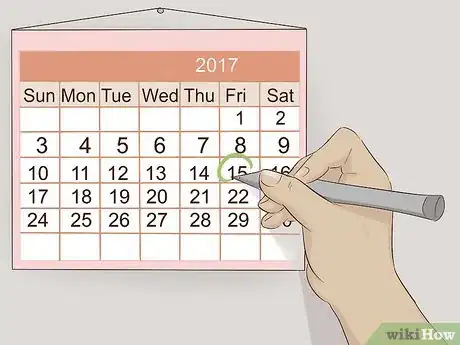
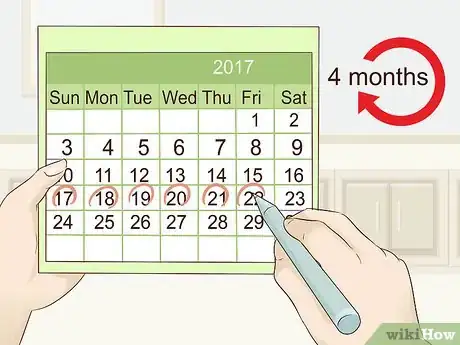
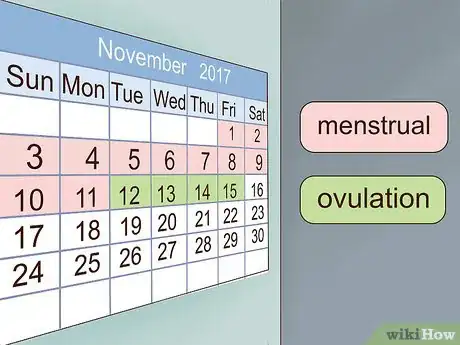
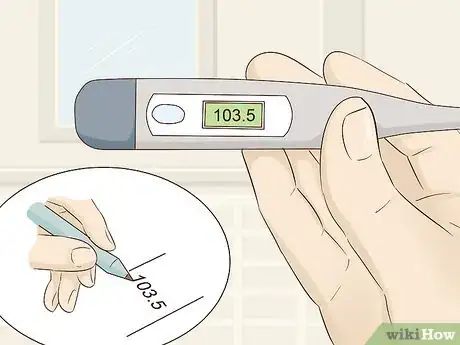
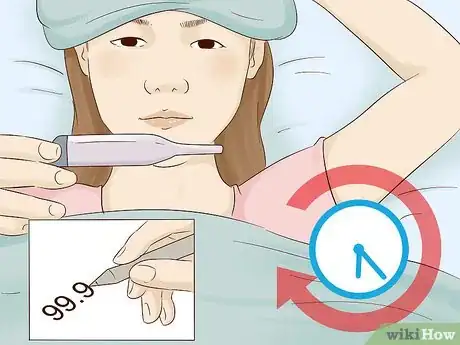


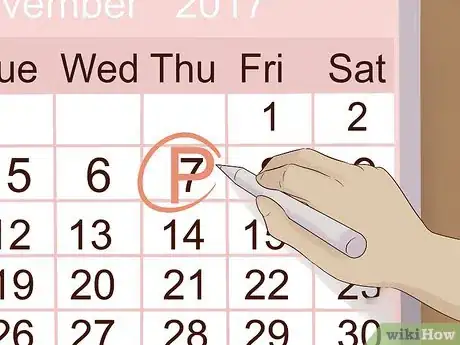
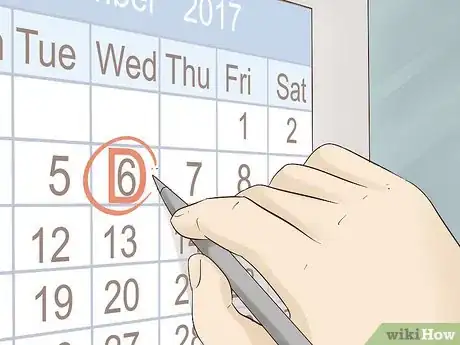
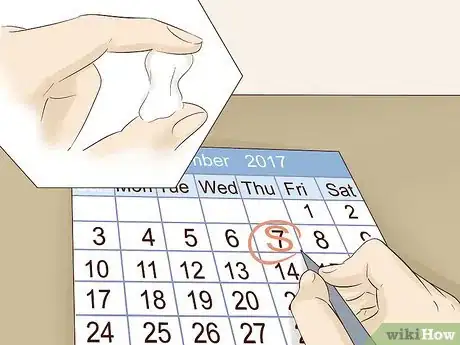

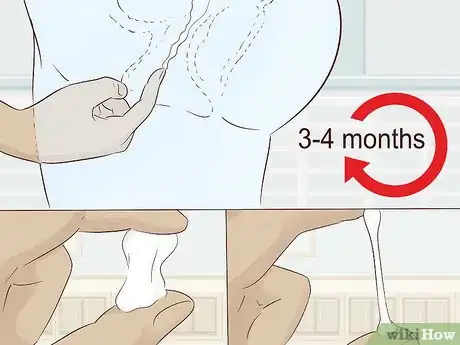




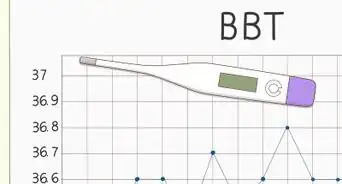
























































Medical Disclaimer
The content of this article is not intended to be a substitute for professional medical advice, examination, diagnosis, or treatment. You should always contact your doctor or other qualified healthcare professional before starting, changing, or stopping any kind of health treatment.
Read More...